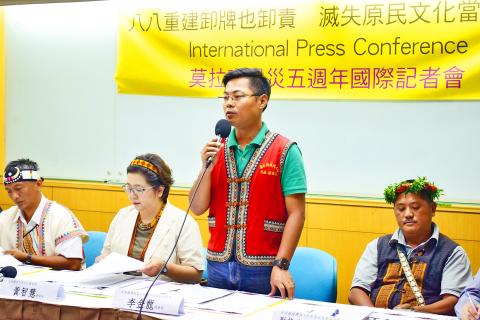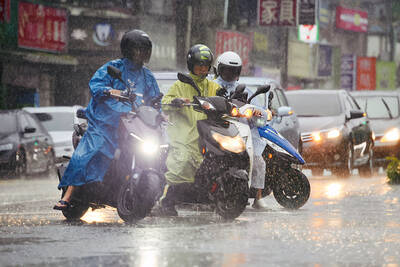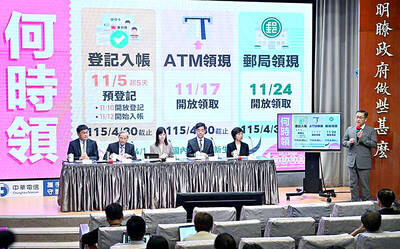As the government celebrates what it termed the “successful reconstruction” of areas devastated by Typhoon Morakot in 2009 and launched an exhibition highlighting reconstruction results, Morakot survivors yesterday accused the government of lying, saying that reconstruction is far from complete.
Morakot is considered the worst storm to hit the nation in 50 years; its massive mudslides caused almost 700 deaths, permanently changed the landscape and forced thousands of people to relocate.
Siaolin Village (小林) in what is now Jiasian Township (甲仙), Greater Kaohsiung, was completed buried by mudslides.

Photo: Courtesy of the Taiwan Association for Human Rights
While the government celebrates what it called the completion of reconstruction five years after the disaster, many survivors disagreed.
“When reconstruction efforts started, the government promised that people would not be relocated too far from where they originally lived, but it is a lie,” Huang Chih-huei (黃智慧), director of Millet Foundation of Indigenous Peoples, told a news conference in Taipei. “The government relocated Rukai residents of Ali Village (阿里) to a different township, forcing them to spend NT$500 per day on gas to drive to and from work on fields in their original village,” Huang said. “It is impossible for these villagers to farm as they used to.”
“In addition, each household has been moved to a house of 16 ping [52.8m2], where it is very difficult for a big family to live,” he said.
Lee Jin-long (李金龍), director of the Industrial Development Association for the Rukai Village of Kocapognan, agreed.
“Ali Village residents were evicted and relocated without their consent, despite the original village not being too seriously damaged,” Lee said. “Besides, the government never asked for their opinions before building the new village, making it a place with no connection to Rukai culture and tradition.”
Lee said that although they have houses, their lives have not been rebuilt, since their farmlands are far away.
Isnankan Dahay, a resident of the Bunun Aboriginal Village of Nansalu (南沙魯) in Namasiya District (那瑪夏), Kaohsiung, said that at the time, the government promised to allocate farmland to each household, “but it never happened.”
With no source of income, many villagers — himself included — moved back to the original village where they have farms, he said.
“The government said that Nanshalu wouldn’t be suitable for residents for at least 50 years,” Dahay said. “Well, I’ve been back for five years now and everything is fine.”
Taiwan Association for Human Rights Secretary-General Tsai Chi-hsun (蔡季勳) said that many people — especially Aborigines forced to relocate — are still struggling to rebuild their lives, but the government is not helping, but rather is creating obstacles for them.
“This is why we’ve always stressed the importance of information transparency and public participation in decisions,” Tsai said. “Otherwise, anyone could be forced to relocate or give up their lifestyle due to government decisions.”

The combined effect of the monsoon, the outer rim of Typhoon Fengshen and a low-pressure system is expected to bring significant rainfall this week to various parts of the nation, the Central Weather Administration (CWA) said. The heaviest rain is expected to occur today and tomorrow, with torrential rain expected in Keelung’s north coast, Yilan and the mountainous regions of Taipei and New Taipei City, the CWA said. Rivers could rise rapidly, and residents should stay away from riverbanks and avoid going to the mountains or engaging in water activities, it said. Scattered showers are expected today in central and

People can preregister to receive their NT$10,000 (US$325) cash distributed from the central government on Nov. 5 after President William Lai (賴清德) yesterday signed the Special Budget for Strengthening Economic, Social and National Security Resilience, the Executive Yuan told a news conference last night. The special budget, passed by the Legislative Yuan on Friday last week with a cash handout budget of NT$236 billion, was officially submitted to the Executive Yuan and the Presidential Office yesterday afternoon. People can register through the official Web site at https://10000.gov.tw to have the funds deposited into their bank accounts, withdraw the funds at automated teller

COOPERATION: Taiwan is aligning closely with US strategic objectives on various matters, including China’s rare earths restrictions, the Ministry of Foreign Affairs said Taiwan could deal with China’s tightened export controls on rare earth metals by turning to “urban mining,” a researcher said yesterday. Rare earth metals, which are used in semiconductors and other electronic components, could be recovered from industrial or electronic waste to reduce reliance on imports, National Cheng Kung University Department of Resources Engineering professor Lee Cheng-han (李政翰) said. Despite their name, rare earth elements are not actually rare — their abundance in the Earth’s crust is relatively high, but they are dispersed, making extraction and refining energy-intensive and environmentally damaging, he said, adding that many countries have opted to

PEACE AND STABILITY: Maintaining the cross-strait ‘status quo’ has long been the government’s position, the Ministry of Foreign Affairs said Taiwan is committed to maintaining the cross-strait “status quo” and seeks no escalation of tensions, the Ministry of Foreign Affairs (MOFA) said yesterday, rebutting a Time magazine opinion piece that described President William Lai (賴清德) as a “reckless leader.” The article, titled “The US Must Beware of Taiwan’s Reckless Leader,” was written by Lyle Goldstein, director of the Asia Program at the Washington-based Defense Priorities think tank. Goldstein wrote that Taiwan is “the world’s most dangerous flashpoint” amid ongoing conflicts in the Middle East and Russia’s invasion of Ukraine. He said that the situation in the Taiwan Strait has become less stable